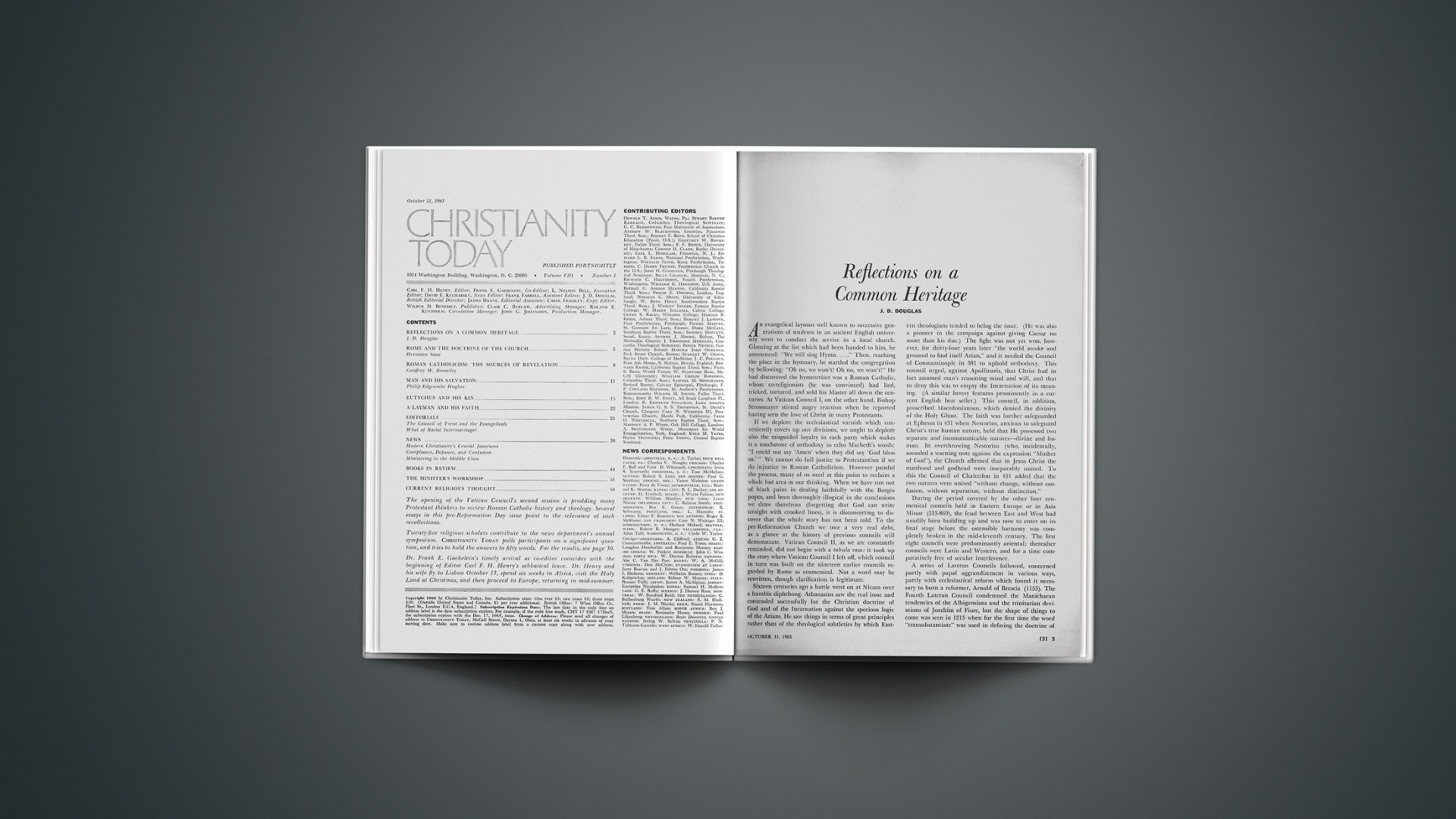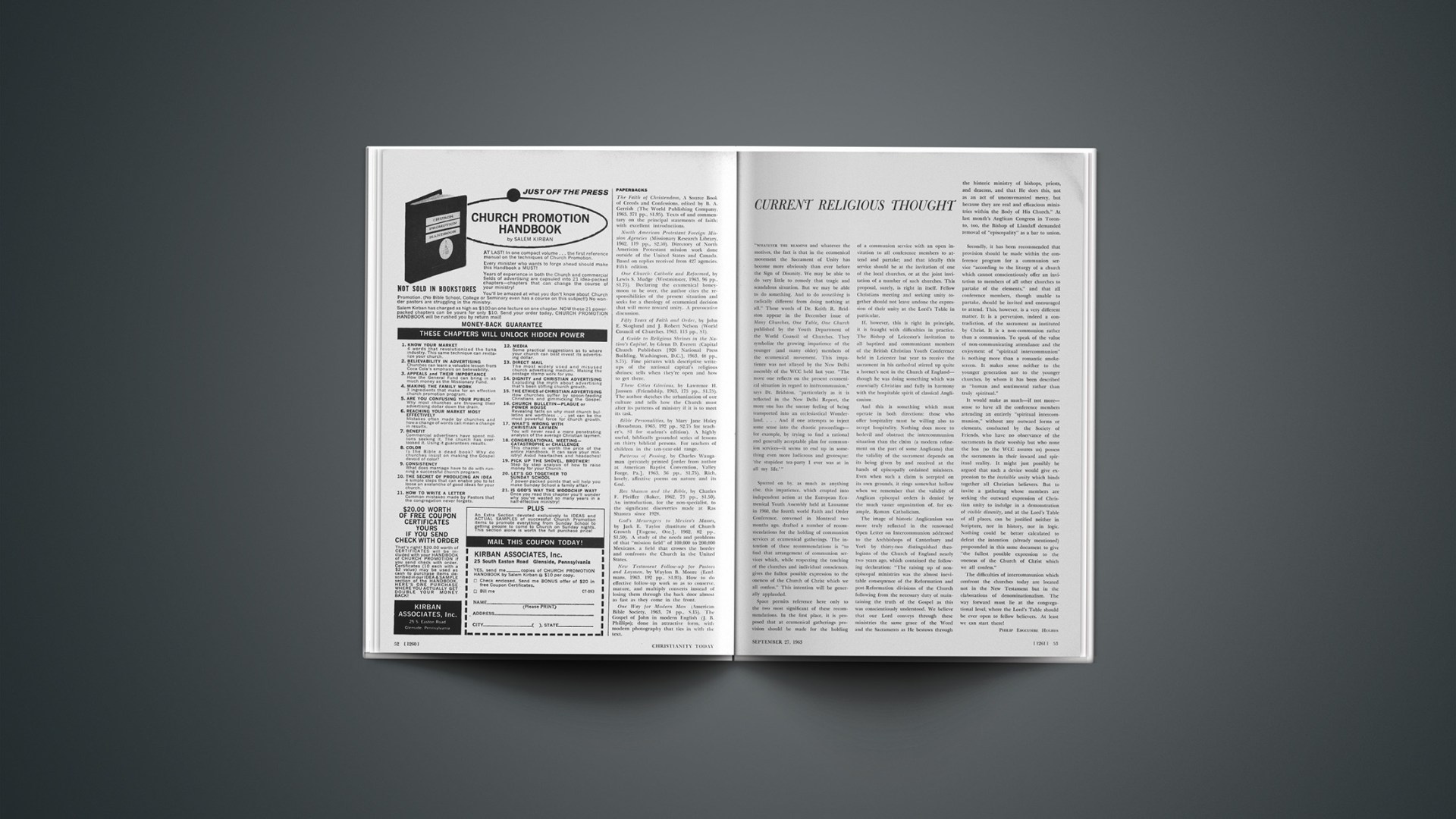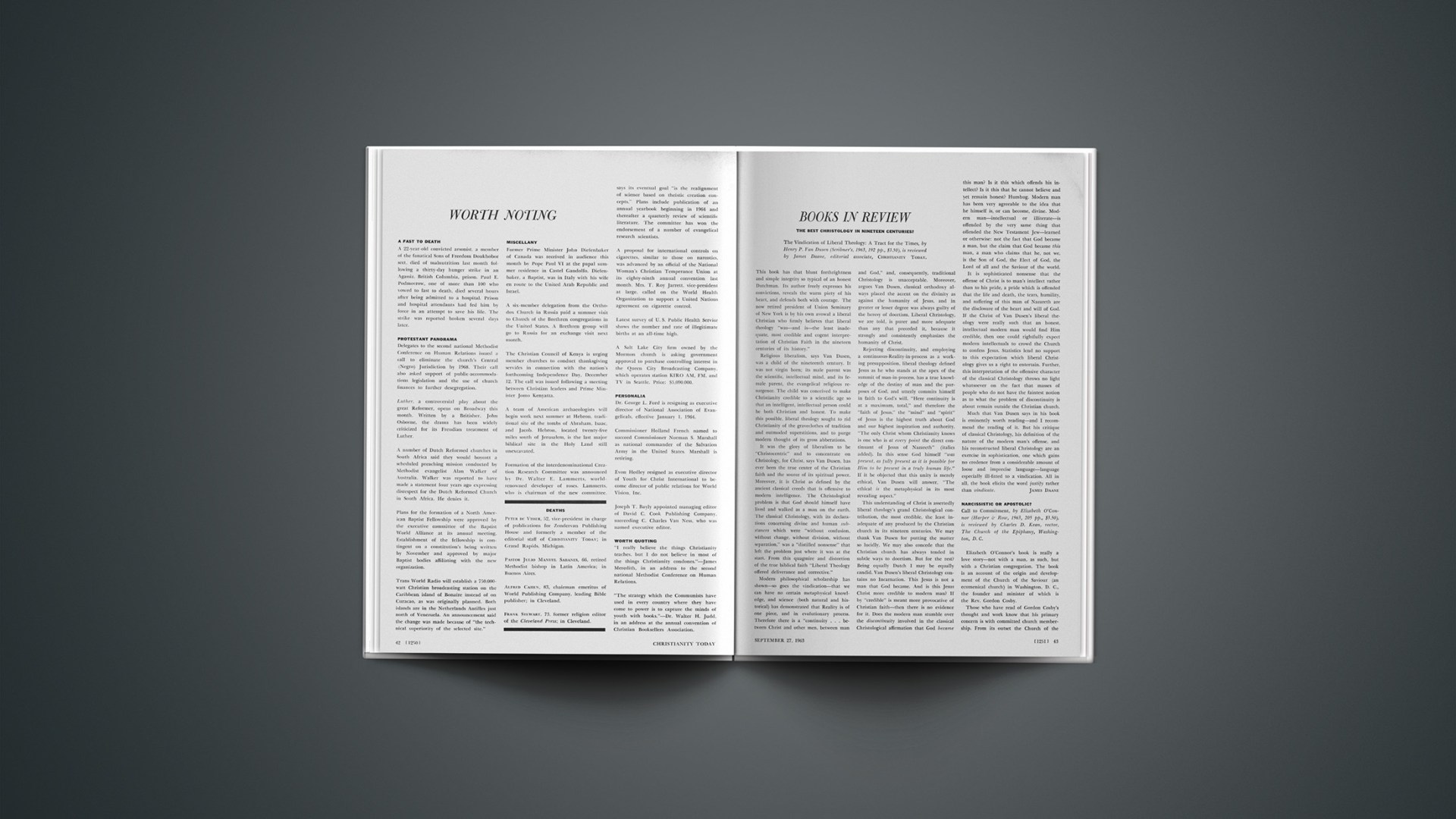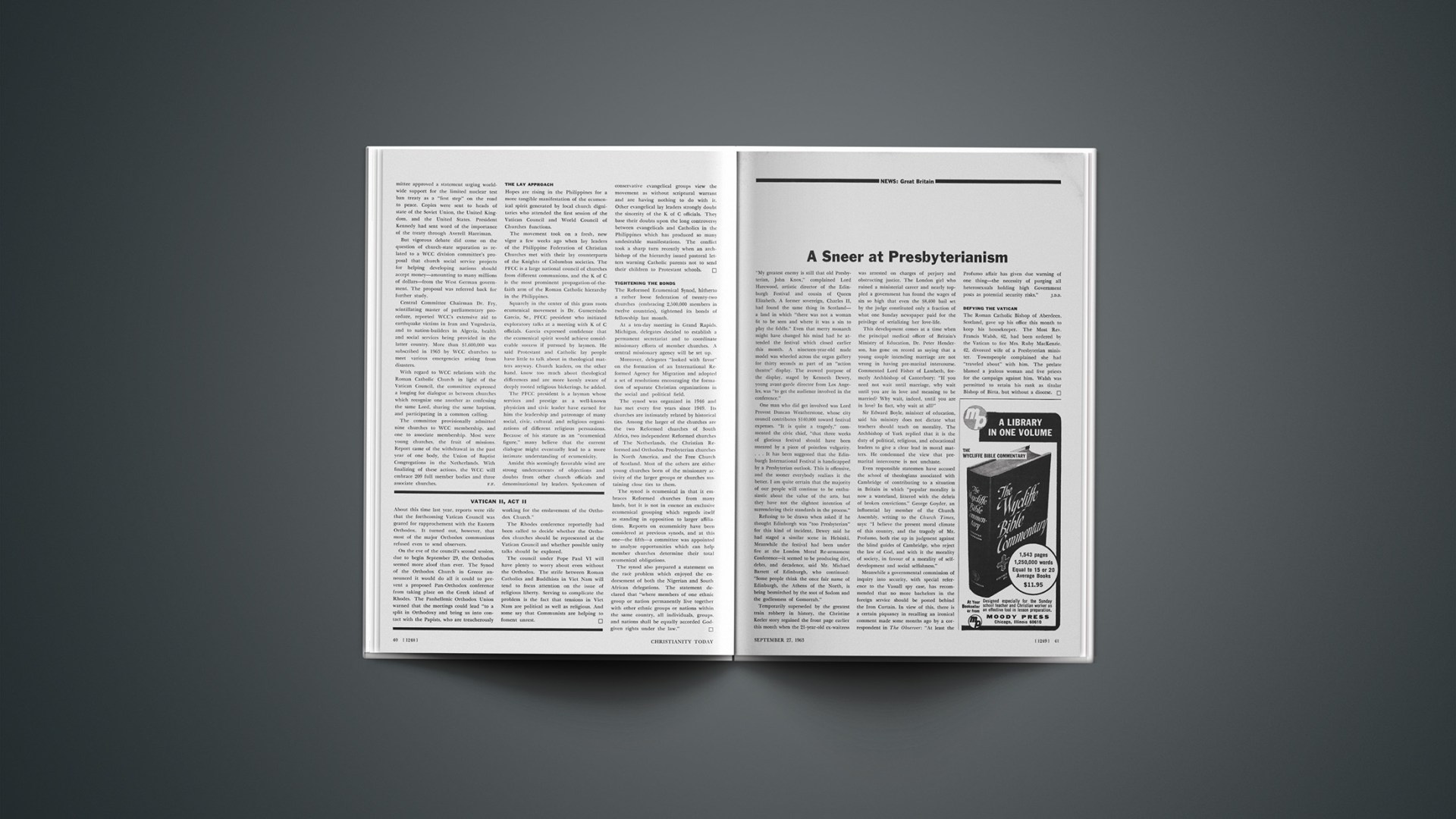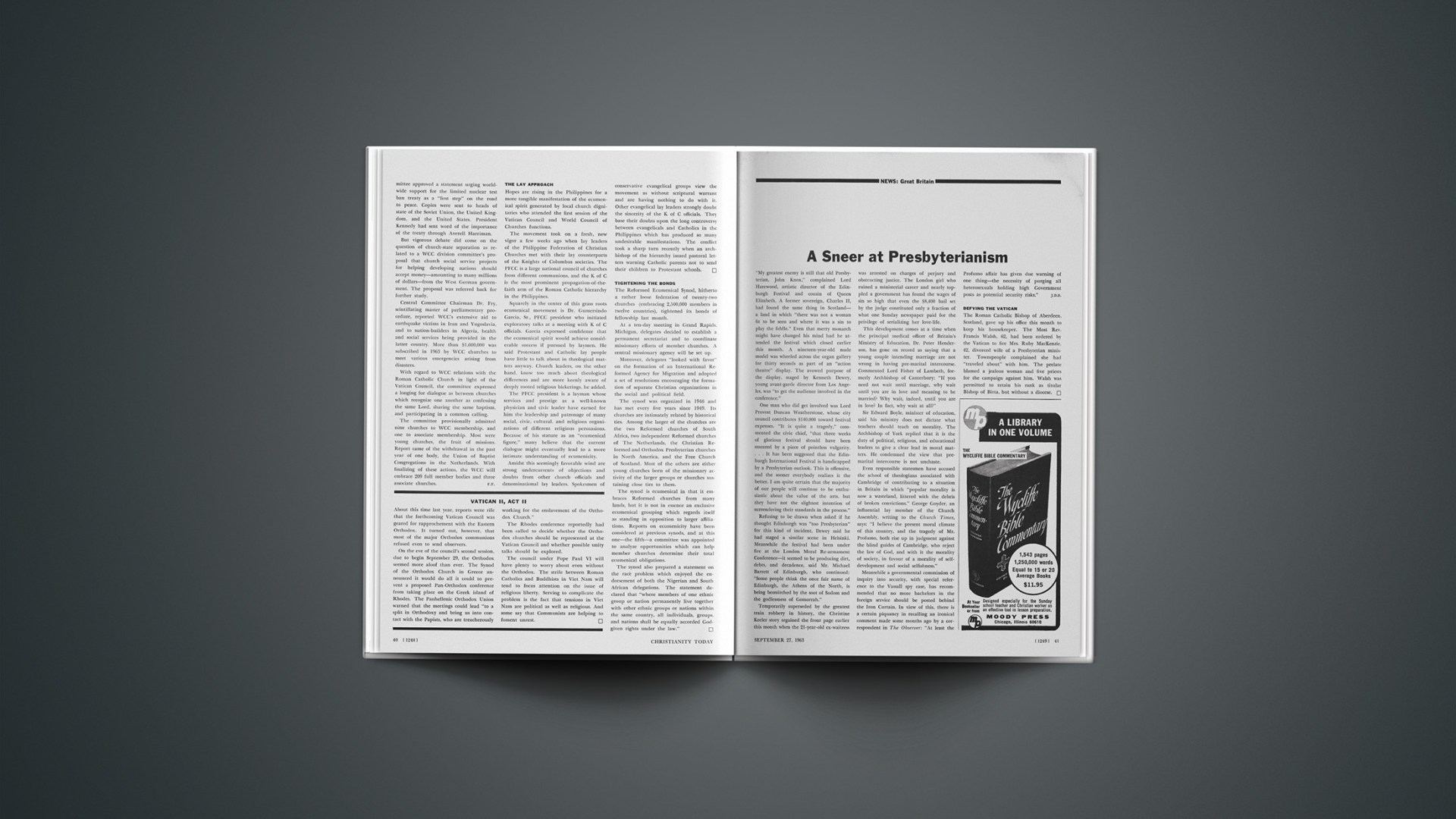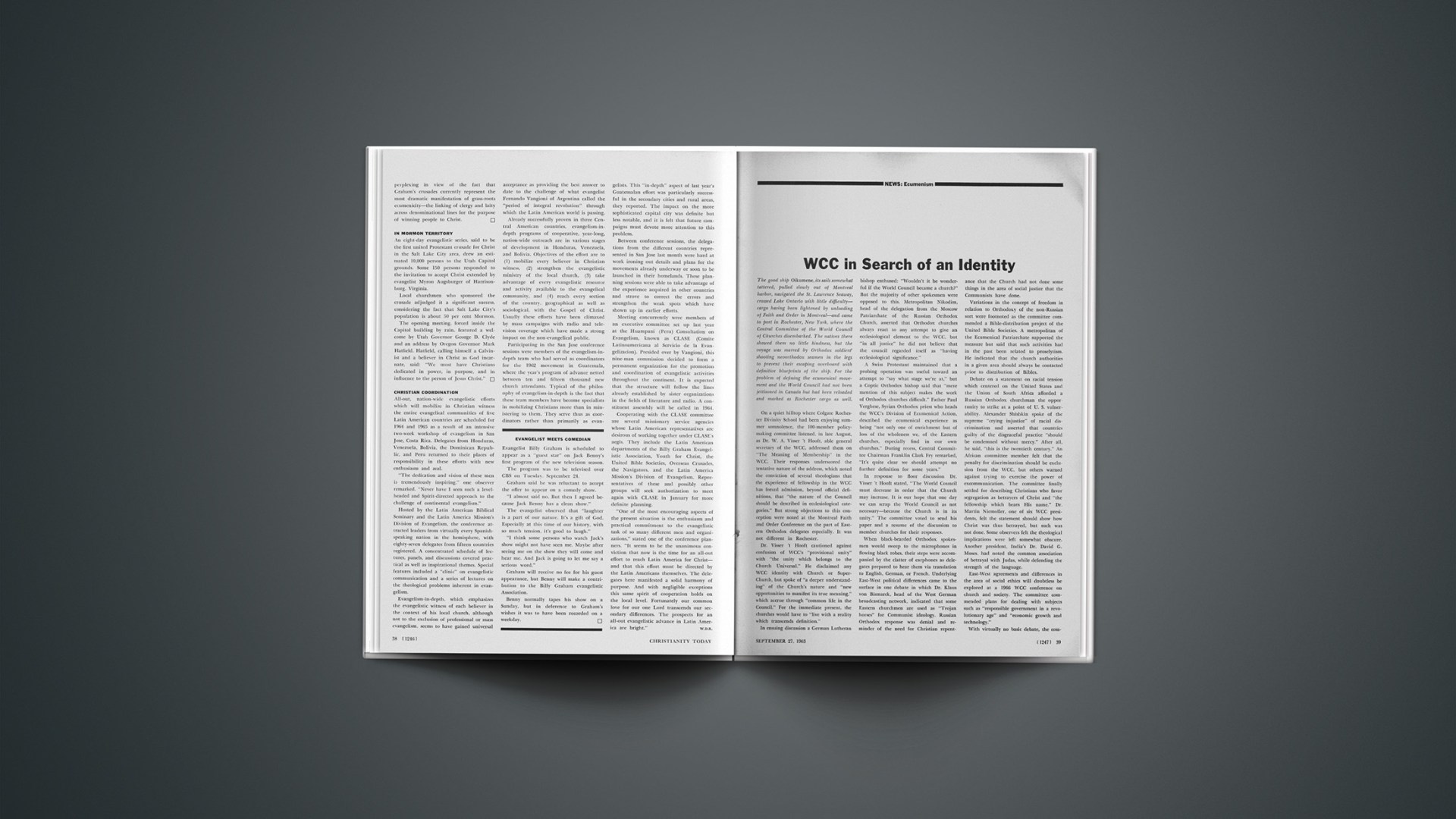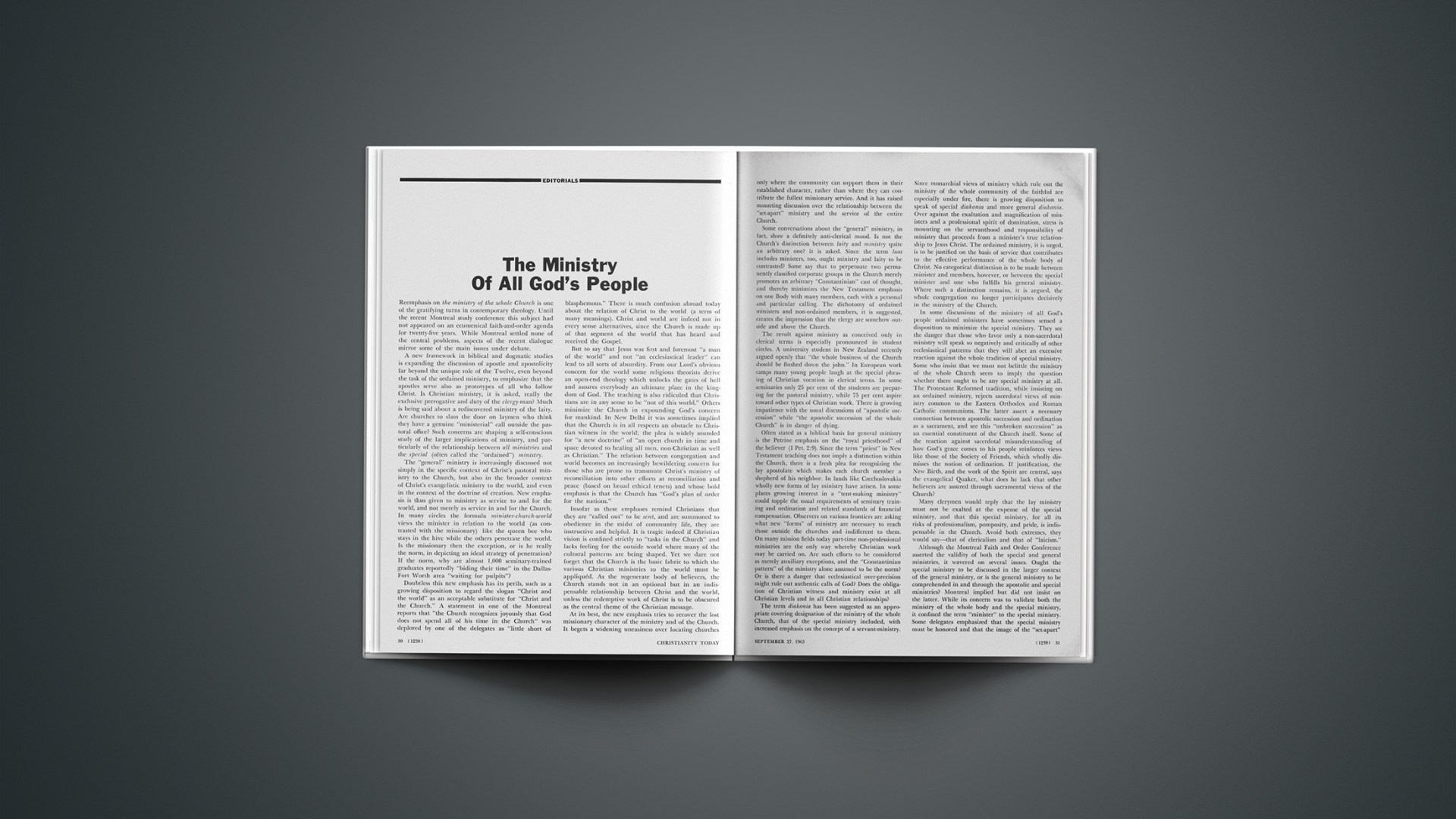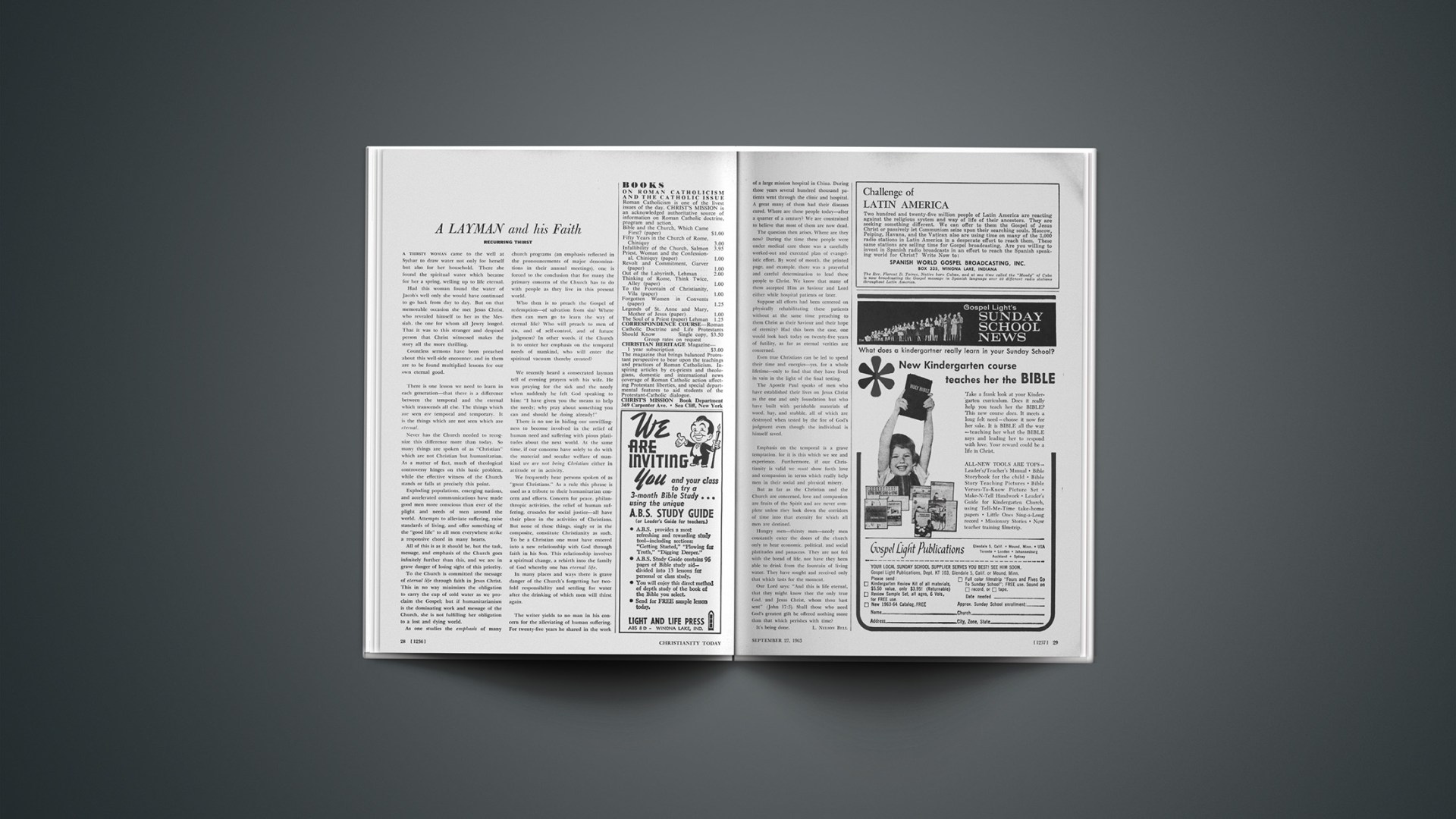An evangelical layman well known to successive generations of students in an ancient English university went to conduct the service in a local church. Glancing at the list which had been handed to him, he announced: “We will sing Hymn Then, reaching the place in the hymnary, he startled the congregation by bellowing: “Oh no, we won’t! Oh no, we won’t!” He had discovered the hymnwriter was a Roman Catholic, whose co-religionists (he was convinced) had lied, tricked, tortured, and sold his Master all down the centuries. At Vatican Council I, on the other hand, Bishop Strossmayer stirred angry reaction when he reported having seen the love of Christ in many Protestants.
If we deplore the ecclesiastical varnish which conveniently covers up our divisions, we ought to deplore also the misguided loyalty in each party which makes it a touchstone of orthodoxy to echo Macbeth’s words: “I could not say ‘Amen’ when they did say ‘God bless us.’ ” We cannot do full justice to Protestantism if we do injustice to Roman Catholicism. However painful the process, many of us need at this point to reclaim a whole lost area in our thinking. When we have run out of black paint in dealing faithfully with the Borgia popes, and been thoroughly illogical in the conclusions we draw therefrom (forgetting that God can write straight with crooked lines), it is disconcerting to discover that the whole story has not been told. To the pre-Reformation Church we owe a very real debt, as a glance at the history of previous councils will demonstrate. Vatican Council II, as we are constantly reminded, did not begin with a tabula rasa: it took up the story where Vatican Council I left off, which council in turn was built on the nineteen earlier councils regarded by Rome as ecumenical. Not a word may be rewritten, though clarification is legitimate.
Sixteen centuries ago a battle went on at Nicaea over a humble diphthong. Athanasius saw the real issue and contended successfully for the Christian doctrine of God and of the Incarnation against the specious logic of the Arians. He saw things in terms of great principles rather than of the theological subtleties by which Eastern theologians tended to befog the issue. (He was also a pioneer in the campaign against giving Caesar no more than his due.) The fight was not yet won, however, for thirty-four years later “the world awoke and groaned to find itself Arian,” and it needed the Council of Constantinople in 381 to uphold orthodoxy. This council urged, against Apollinaris, that Christ had in fact assumed man’s reasoning mind and will, and that to deny this was to empty the Incarnation of its meaning. (A similar heresy features prominently in a current English best seller.) This council, in addition, proscribed Macedonianism, which denied the divinity of the Holy Ghost. The faith was further safeguarded at Ephesus in 431 when Nestorius, anxious to safeguard Christ’s true human nature, held that He possessed two separate and incommunicable natures—divine and human. In overthrowing Nestorius (who, incidentally, sounded a warning note against the expression “Mother of God”), the Church affirmed that in Jesus Christ the manhood and godhead were inseparably united. To this the Council of Chalcedon in 451 added that the two natures were united “without change, without confusion, without separation, without distinction.”
During the period covered by the other four ecumenical councils held in Eastern Europe or in Asia Minor (553–869), the feud between East and West had steadily been building up and was now to enter on its final stage before the ostensible harmony was completely broken in the mid-eleventh century. The first eight councils were predominantly oriental; thereafter councils were Latin and Western, and for a time comparatively free of secular interference.
A series of Lateran Councils followed, concerned partly with papal aggrandizement in various ways, partly with ecclesiastical reform which found it necessary to burn a reformer, Arnold of Brescia (1155). The Fourth Lateran Council condemned the Manichaean tendencies of the Albigensians and the trinitarian deviations of Joachim of Fiore, but the shape of things to come was seen in 1215 when for the first time the word “transubstantiate” was used in defining the doctrine of the Eucharist. Political and nationalistic factors were looming ever larger. The first of two councils at Lyons in the thirteenth century formally deposed the Emperor Frederick II as an anti-ecclesiastic and suspected heretic; the second saw the Greek church for diplomatic reasons reuniting with Rome, with the Eastern emperor’s legates even repeating three times the odious Filioque clause. (The marriage of convenience was to end fifteen years later.)
The “reformation in head and in members” talked of at the Council of Vienne (1311) was finally avoided at Constance a century later with the condemnation of Wycliffe and Hus, though some half-hearted attempts were made at the Council of Basel which began in 1431. A significant change took place about this era. “We hear no more of Councils for some time,” comments Neville Figgis, “save as a threat in the regular way of diplomatic business.” The Fifth Lateran Council (1512–17) defended the immortality and individuality of the soul, and denied that philosophical truth is independent of revealed dogma.
In 1545 the Council of Trent was convoked by Paul 111, and it continued under the next four popes until 1563. It reaffirmed the Niceno-Constantinopolitan Creed as the basis of faith, and asserted the equal validity of Scripture and tradition as sources of religious truth, the sole right of the Church to interpret the Bible, and the authority of the text of the Vulgate. It defined the theology of the seven Christ-instituted sacraments and held to their necessity to salvation. The council also affirmed transubstantiation, repudiated the Lutheran, Calvinist, and Zwinglian eucharistic doctrines, denied the chalice to the laity, defined the sacrifice of the Mass, and dealt somewhat cursorily with purgatory, the invocation of saints, the veneration of relics and images, and indulgences. Though there is here much unscriptural accretion, the catechism of the Council of Trent upheld the doctrine of the Trinity: Christ is represented as “the Son of God, and true God, as is the Father who begot him from Eternity.” Continues the catechism: “… he is the second person of the blessed Trinity, equal in all things to the Father and the Holy Ghost.” It is the Spirit, moreover, “who infuses into us spiritual life.” The same council reiterated the efficacy of Christ’s death, but added those peripheral features that no Protestant could accept. No one who studies the Roman church can afford to neglect the decrees and canons of this council.
Summoned by Pius IX in 1869, Vatican Council I widened the gulf with Protestantism: it decreed the infallibility of the pope when speaking ex cathedra, that is, “when, as shepherd and teacher of all Christians, he defines a doctrine concerning faith and morals to be held by the whole Church.” The council deplored the pantheism, materialism, and rationalism of the time, and defined the respective spheres of reason and faith, especially with the intention of excluding traditionalism (which made an act of faith in a revealed tradition the origin of all knowledge).
The impression is sometimes given in our day that one of the chief difficulties between Protestants and Romans lies in terminology. An eminent theologian, Father G. H. Tavard, discussing free justification, Scripture, and faith, suggests that when these are “properly understood there is no irreducible fundamental contradiction between them and Catholic doctrine.” This is a pleasingly specious thesis. One might point, for example, to the number of speeches in the opening months of Vatican Council II reflecting a reverence for Scripture—a reverence seen in Leo XIII’s encyclical of 1893, and in Gregory the Great (d. 604), who said: “When we are persuaded that the Holy Spirit was its author, in stirring a question about the author [of any biblical book], what else do we do than in reading a letter inquire about the pen?” But, of course, Rome speaks also of tradition, and here we hit the crux of the matter, as Karl Barth thus points out in a recent interview: “In my view the greatest obstacle to rapprochement between the Reformed Church and the Catholic Church is a tiny little word which the Roman Church adds after each of our statements: the word ‘and.’ When we say Jesus, the Catholics say Jesus and Mary. We try to obey Christ as our only Lord; the Catholics obey Christ and his representative on earth, the Pope. We believe that Christians are saved by the merits of Jesus Christ; the Catholics add, ‘and by their own merits,’ i.e., by their works. We believe that the sole source of Revelation is Scripture; the Catholics add ‘and tradition.’ We say that knowledge of God is obtained through faith in his Word as expressed in the Scriptures; the Catholics add ‘and through reason.’ ” Taking up the same point, Oscar Cullmann says: “I believe that dialogue will move forward when our Catholic brethren cease to look negatively on this ‘not quite enough’ in what they find in us; that is, when they do not see it as something missing, as a result of arbitrary reduction, but as a concentration, made under the prompting of the Holy Spirit, upon what we feel ought to form the nucleus of our faith in Christ.”
The Cambridge layman referred to at the beginning of this essay gives the impression of measuring his distance from God by his distance from Rome, perhaps forgetting that Rome is impeccably orthodox in some doctrines (such as the Resurrection and original sin) which divide his fellow Protestants. All who call themselves Christians are facing a hostile world; many of the themes to be discussed by Vatican Council II involve problems not peculiar to Roman Catholicism: the continued secularization through technical advances and social well-being; the division of the world into two or three blocs, and the danger of self-annihilation; the universal movement toward nationalism exploited by international Communism; the menace to Christianity from the militant atheism of totalitarian regimes. Even in an age when more than ever men have lost sight of their eternal destiny, not all will interpret such terms of reference as a summons to ecumenical compromise. But none will deny that Paul’s word to the Ephesians is still a word for today: “Use the present opportunity to the full, for these are evil days” (NEB).

